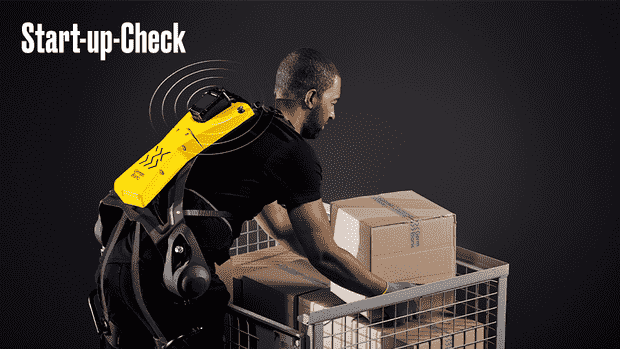The company has further developed prototypes from a research project.
Dusseldorf At the beginning of January it was showtime in Las Vegas for German Bionic’s exoskeletons. The German start-up presented its high-tech backpacks at the electronics trade fair CES, which support workers in lifting and carrying. The show was rewarded with one of the “Best of Innovation” awards, and a number of US media reported fascinated about the mechanical everyday aids.
The prestige success comes in an important phase. The management wants to start series production this year, so it is important to win customers. Especially in North America: “We assume that the USA will become the strongest market,” says Armin G. Schmidt, head of the electronics manufacturer. However, the competition is tough.
Who is the person you are talking about?
German Bionic emerged from a university research project on the use of exoskeletons in industry. When the funding ended, Peter Heiligensetzer and Armin G. Schmidt decided to further develop one of the prototypes. In 2017 they founded together with the investor Michael Halbherr in Augsburg.
The company has developed several products over the years: six generations of the exoskeleton, a safety vest with sensors, and a cloud platform. “We don’t see ourselves as just a hardware company,” emphasizes Schmidt, who took over the post in 2018. Data analysis is designed to help customers do their work healthily and efficiently.
The German Bionic system provides a relief of up to 30 kilograms.
How does the technology work?
The “Apogee Power Suit” – as the current model is called – vaguely resembles a backpack with a hard shell that is attached to the shoulders, hips and thighs. The device weighs around 7.5 kilograms, which is about the same as well-filled hiking luggage.
The power suit, which costs almost 10,000 euros, offers considerable support for this. The device has motors and gears. Together they act like an electronic muscle that relieves the lower back by up to 30 kilograms. In a logistics center or factory, support can add up to several tons per employee over the course of a day, emphasizes Schmidt.
The exoskeleton is not high-tech armor for superheroes, as technology might suggest, but an everyday tool in factories and warehouses. It’s sort of like Iron Man’s little brother.
Will this become a trend?
The search for skilled workers is becoming increasingly difficult, especially in aging societies. Companies must therefore do something to ensure that their employees stay healthy for a long time. “Our vision is that we can keep people fit longer with wearable tools,” says Schmidt.
The manager currently sees the greatest potential in sectors such as industry and logistics. Customers include Dachser and DPD, as well as some airports and trading companies. However, the use of the technology also makes sense in other sectors, such as healthcare and care.
Based on various studies, German Bionic estimates that the market for exoskeletons will grow by an average of 43 percent to 20.8 billion dollars by 2030. When that happens, the niche becomes a mass market.
What’s next?
German Bionic has made its products ready for series production with a total of almost 50 million dollars in outside capital. So far, however, the start-up has sold comparatively small quantities. According to the company, sales are in the double-digit million range, but it does not give exact business figures.
Mass production is now pending, and the car supplier Mubea will manufacture the devices. The demand is now high, emphasizes Schmidt: “Word has got around that the technology can be used sensibly.”
The start-up is seeing more orders and, more recently, larger quantities, sometimes hundreds of devices at a time. This is important for the business plan: “According to current forecasts, we are fully financed until we break even.”
However, other manufacturers also want to seize the opportunity. According to Schmidt, several manufacturers in the USA and Japan are working on active exoskeletons with motors. “It’s a bit of a slog.” This was also noticeable at the CES: quite a few employees from the competition came to the stand.
Every week, the Handelsblatt presents young companies that managers, entrepreneurs and those interested in business should now take a look at. The focus is on the innovation potential, which investors also pay particular attention to. The business models and ideas could also provide new impetus for products and solutions in other sectors.
More: You can find more start-up checks here

